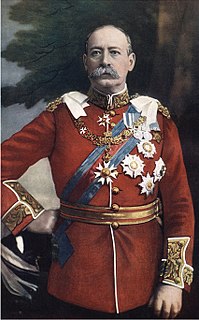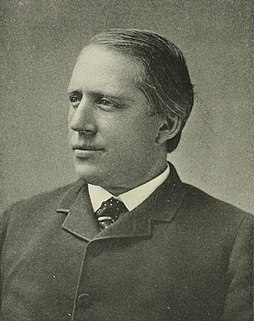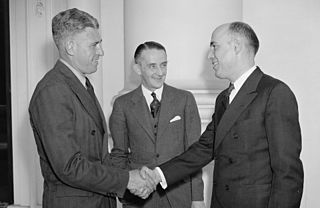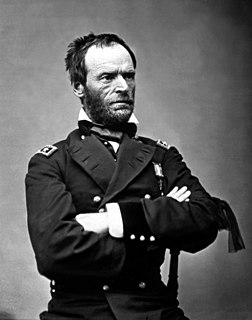
Edgar Purnell Hooley was a Welsh inventor. After inventing tarmac in 1902, he founded Tar Macadam Syndicate Ltd the following year and registered tarmac as a trademark. Following a merger in 2013 the business became Tarmac Limited, one of the United Kingdom's largest building materials companies.

William Wallace Wotherspoon was a United States Army general who served as Chief of Staff of the United States Army in 1914.

Field Marshal Francis Wallace Grenfell, 1st Baron Grenfell, was a British Army officer. After serving as aide-de-camp to the Commander-in-Chief, South Africa, he fought in the 9th Xhosa War, the Anglo-Zulu War and then the Anglo-Egyptian War. He went on to become Sirdar (Commander-in-Chief) of the Egyptian Army and commanded the forces at the Battle of Suakin in December 1888 and at the Battle of Toski in August 1889 during the Mahdist War. After that he became Governor of Malta and then Commander-in-Chief, Ireland before retiring in 1908.
William DuBois may refer to:

Arthur Pue Gorman was a United States Senator from Maryland, serving from 1881 to 1899 and from 1903 to 1906. He also served in the Maryland House of Delegates from 1869 to 1875, and the Maryland State Senate to 1881. He was a prominent leader of the Bourbon Democrat faction in the Democratic Party and later served as a member of the Mills Commission which investigated the origins of the sport of baseball and established its inventor.

Prince Albert William Henry of Prussia was a younger brother of German Emperor William II and a Prince of Prussia. He was also a grandson of Queen Victoria. A career naval officer, he held various commands in the Imperial German Navy, eventually rose to the rank of Grand Admiral and Generalinspekteur der Marine.

East Potomac Park is a park located on a man-made island in the Potomac River in Washington, D.C., in the United States. The park lies southeast of the Jefferson Memorial and the 14th Street Bridge, and the park lies between the Washington Channel and the Potomac River. Amenities in East Potomac Park include the East Potomac Park Golf Course, a miniature golf course, a public swimming pool, tennis courts, and several athletic fields. The park is a popular spot for fishermen, and cyclists, walkers, inline skaters, and runners heavily use the park's roads and paths. A portion of Ohio Drive SW runs along the perimeter of the park.

William Emerson Barrett was an American journalist and politician.

George Manville Fenn was a prolific English novelist, journalist, editor and educationalist. Many of his novels were written for young adults. His final book was a biography of his fellow writer for juveniles, George Alfred Henty.
Armistead Rust was an officer of the United States Navy.

Howell Gardner Crim was an American civil servant best known for being the Chief Usher of the White House in Washington, D.C., from 1938 to 1957.

Raymond Douglas Muir was an American civil servant who served as Chief Usher in the White House from 1933 to 1938, and Deputy Chief of Protocol for the United States Department of State from 1951 until his death in 1954.

Thomas E. Stone was an American civil servant who served as Chief Usher of the White House in Washington, D.C., from 1901 and 1909. Beginning in 1912, Stone worked as an Internal Revenue agent for the United States Department of the Treasury, where he won national acclaim for breaking major crime rings and capturing individuals who had fled from justice. He helped set up enforcement of Prohibition in several states in 1920, and helped break the largest illegal alcohol production ring in the United States in 1925. He served in a wide variety of positions with the Bureau of Prohibition, including chief of the 7th District from 1929 until his retirement in 1934.
Edson S. Densmore was an American civil servant who served as a Doorkeeper to the President of the United States from 1885 to 1887, and as Chief Usher of the White House in Washington, D.C., briefly in 1887 and again from March 1889 until his death in November 1892.
John Francis McKenna was an Irish American civil servant who served as Chief Usher of the White House in Washington, D.C., from 1887 to 1889.
Axel Teodor Danielson, was a Swedish editor-in-chief.

Saint Stephen Martyr Catholic Church is a Catholic parish church located at 2436 Pennsylvania Avenue NW in Washington, D.C., in the United States. The parish was founded on August 4, 1867, and the first church building consecrated and used for worship on December 27, 1868. This brick structure closed on July 15, 1959, and the current new building was consecrated and first used for worship on June 11, 1961. The church was a favorite of President John F. Kennedy.





















